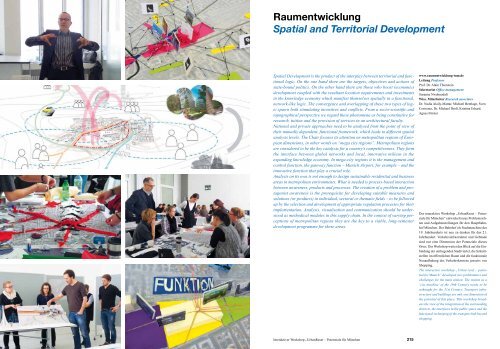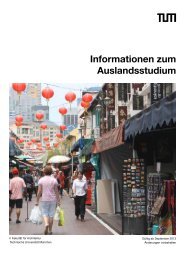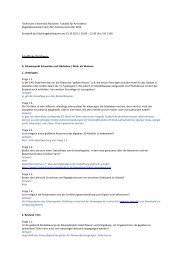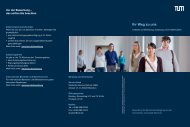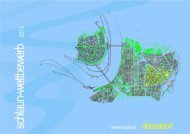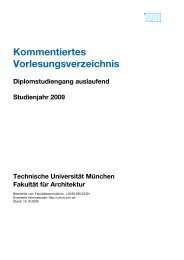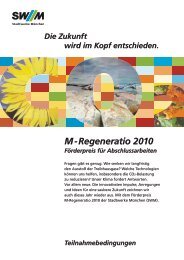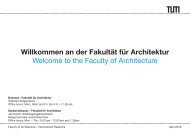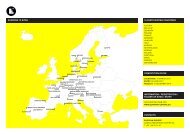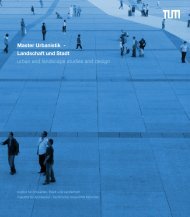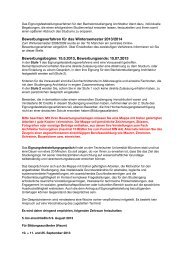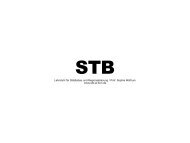Institute Institutes - Fakultät für Architektur - TUM
Institute Institutes - Fakultät für Architektur - TUM
Institute Institutes - Fakultät für Architektur - TUM
Erfolgreiche ePaper selbst erstellen
Machen Sie aus Ihren PDF Publikationen ein blätterbares Flipbook mit unserer einzigartigen Google optimierten e-Paper Software.
Raumentwicklung<br />
Spatial and Territorial Development<br />
Spatial Development is the product of the interplay between territorial and functional<br />
logic. On the one hand there are the targets, objectives and actions of<br />
state-bound politics. On the other hand there are those who boost (economic)<br />
development coupled with the resultant location requirements and investments<br />
in the knowledge economy which manifest themselves spatially in a functional,<br />
network-like logic. The convergence and overlapping of these two types of logic<br />
spawn both stimulating incentives and conflicts. From a socio-scientific and<br />
topographical perspective we regard these phenomena as being constitutive for<br />
research, tuition and the provision of services in an architectural faculty.<br />
National and private approaches need to be analysed from the point of view of<br />
their mutually dependent, functional framework, which leads to different spatial<br />
analysis levels. The Chair focuses its attention on metropolitan regions of European<br />
dimensions, in other words on “mega city regions”. Metropolitan regions<br />
are considered to be the key catalysts for a country’s competitiveness. They form<br />
the interface between global networks and local, innovative milieus in the<br />
expanding knowledge economy. In mega-city regions it is the management and<br />
control function, the gateway function – Munich Airport, for example – and the<br />
innovative function that play a crucial role.<br />
Analysis on its own is not enough to design sustainable residential and business<br />
areas in metropolitan environments. What is needed is process-based interaction<br />
between awareness, products and processes. The creation of a problem and protagonist<br />
awareness is the prerequisite for developing suitable measures and<br />
solutions (or products) in individual, sectoral or thematic fields – to be followed<br />
up by the selection and development of appropriate regulation processes for their<br />
implementation. Analysis, visualisation and communication should be understood<br />
as methodical modules in this supply chain. In the context of varying perceptions<br />
of metropolitan regions they are the key to a viable, long-semester<br />
development programme for these areas.<br />
214 Interaktiver Workshop „UrbanReset – Potenziale <strong>für</strong> München<br />
Raumentwicklung Raumentwicklung<br />
215<br />
www.raumentwicklung-tum.de<br />
Leitung Professor<br />
Prof. Dr. Alain Thierstein<br />
Sekretariat Office management<br />
Susanne Nwabuodafi<br />
Wiss. Mitarbeiter Research associates<br />
Dr. Nadia Alaily-Mattar, Michael Bentlage, Sven<br />
Conventz, Dr. Michael Droß, Kristina Erhard,<br />
Agnes Förster<br />
Der interaktive Workshop „UrbanReset – Potenziale<br />
<strong>für</strong> München“ entwickelt neue Problemsichten<br />
und Aufgabenstellungen <strong>für</strong> den Hauptbahnhof<br />
München. Der Bahnhof als Stadtmaschine des<br />
19. Jahrhunderts ist neu zu denken <strong>für</strong> das 21.<br />
Jahrhundert. Verkehrsinfrastruktur und Gebäude<br />
sind nur eine Dimension der Potenziale dieses<br />
Ortes. Der Workshop weitet den Blick auf die Einbindung<br />
der umliegenden Stadtviertel, die Schnittstellen<br />
im öffentlichen Raum und die funktionale<br />
Neuaufladung des Verkehrsknotens jenseits von<br />
Shopping.<br />
The interactive workshop „Urban reset – potential<br />
for Munich“ developed new problematics and<br />
challenges for the main station. The station as a<br />
‘city machine’ of the 19th Century needs to be<br />
rethought for the 21st Century. Transport infrastructure<br />
and buildings are only one dimension of<br />
the potential of this place. This workshop broadens<br />
the view of the integration of the surrounding<br />
districts, the interfaces in the public space and the<br />
functional recharging of the transport hub beyond<br />
shopping.


